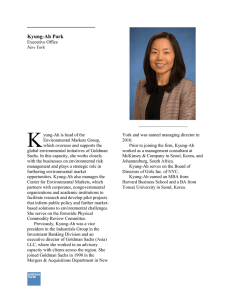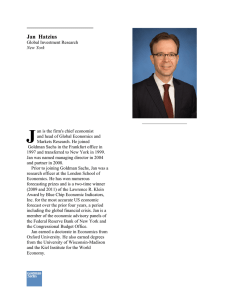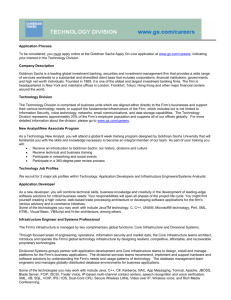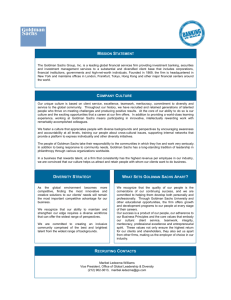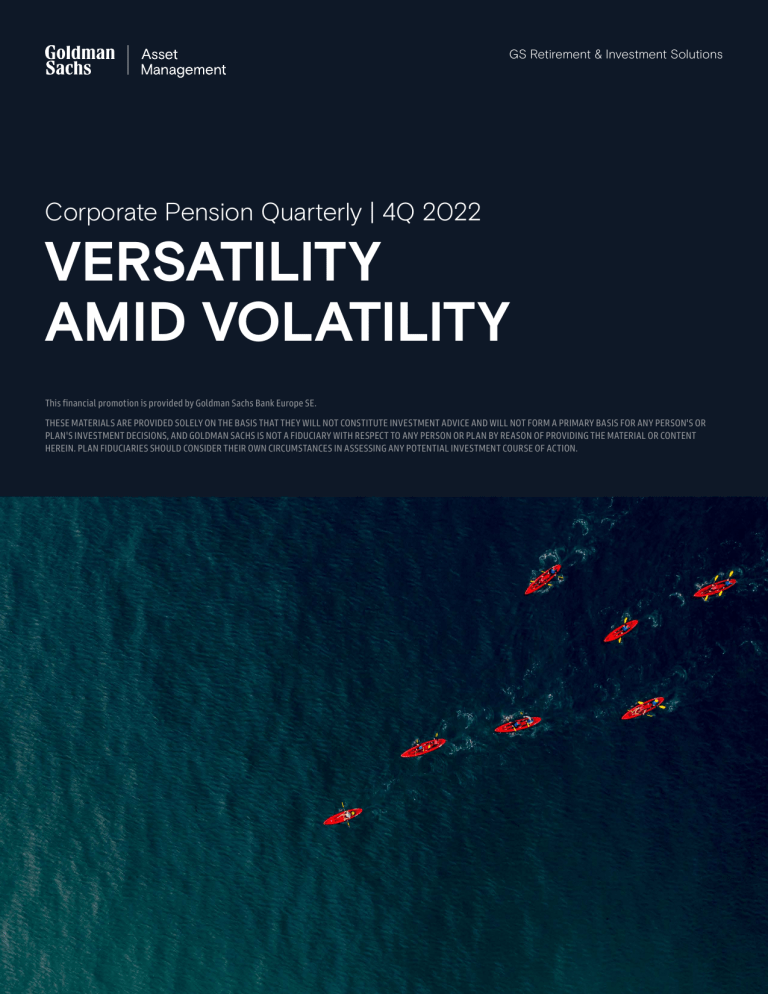
GS Retirement & Investment Solutions Corporate Pension Quarterly | 4Q 2022 VERSATILITY AMID VOLATILITY This financial promotion is provided by Goldman Sachs Bank Europe SE. THESE MATERIALS ARE PROVIDED SOLELY ON THE BASIS THAT THEY WILL NOT CONSTITUTE INVESTMENT ADVICE AND WILL NOT FORM A PRIMARY BASIS FOR ANY PERSON'S OR PLAN'S INVESTMENT DECISIONS, AND GOLDMAN SACHS IS NOT A FIDUCIARY WITH RESPECT TO ANY PERSON OR PLAN BY REASON OF PROVIDING THE MATERIAL OR CONTENT HEREIN. PLAN FIDUCIARIES SHOULD CONSIDER THEIR OWN CIRCUMSTANCES IN ASSESSING ANY POTENTIAL INVESTMENT COURSE OF ACTION. WHAT'S INSIDE 1 Quarterly Snapshot 2 In the News 3 Portfolio Manager Perspectives 4 Strategy in Focus 5 Market Monitor 6 About Us 7 Library CORPORATE PENSION QUARTERLY 4Q 2022: VERSATILITY AMID VOLATILITY Goldman Sachs Asset Management | 2 1. QUARTERLY SNAPSHOT Historical Aggregate S&P 500 Funded Status1 Estimated Funded Status (%) 105 Dec 2021 97.5% 100 95 Dec 2019 87.2% 90 Dec 2022 100.2% • Dec 2020 89.4% • 85 80 • 75 70 2019 2020 2021 2022 • Source: Goldman Sachs Asset Management. As of December 31, 2022. Funded statuses reflect monthly estimates with the exception of year-end data. Distribution of Funded Status1 The past year featured geopolitical uncertainty, peak inflation, aggressive interest rate hikes, and severe drawdowns across markets. Meanwhile, US corporate pension plans ended the year in their strongest position since the 2008 Global Financial Crisis. In 4Q, the Moody’s Aa corporate bond yield, a rate often referenced as a proxy for pension discount rates, fell by 15 bps, thereby increasing the value of aggregate pension liabilities by an estimated 1.5%. Meanwhile, market performance improved in 4Q, bolstered by a recovery in equities. We estimate that, in aggregate, pension asset returns were 6.0%. Quarter-over-quarter, asset returns were greater than liability changes, resulting in our estimate of the funded status for the aggregate S&P 500 plan rising from 96% on September 30th to 100% on December 31st. Market Performance Aggregate GAAP Funded Status of S&P 500 US Defined Benefit Plans (%) Asset Class 4Q Change 2022 Change 2021 Change Asset Returns2 6.0% -20.6% 9.3% US Equity 7.5% -18.1% 28.7% 75th (113%) International Equity3 15.8% -15.0% 9.8% 50th (102%) Fixed Income4 3.2% -24.7% -2.0% Moody’s Aa Corp. Rate -15 bps +226 bps +36 bps Est. Change in Plan Liabilities Due to Discount Rate 1.5% -24.6% 5.0% 99th (144%) 98 96 100 25th (93%) 1st (75%) December 2021 September 2022 (E) December 2022 (E) 1Y Forward Distribution of Funded Status (E)* Source: Goldman Sachs Asset Management and Bloomberg. As of December 31, 2022. Percentage changes represent total returns. Source: Goldman Sachs Asset Management. As of December 31, 2022. E = Estimated by Goldman Sachs Asset Management. *1 year GS Asset Management projected funded status range using estimates of asset/liability returns and volatility. Source: Goldman Sachs Asset Management. As of December 31, 2022. The economic and market forecasts presented herein have been generated by Goldman Sachs Asset Management for informational purposes as of the date of this presentation. They are based on proprietary models and there can be no assurance that the forecasts will be achieved. Please see additional disclosures at the end of this presentation. Past performance does not guarantee future results, which may vary. 1. GAAP funded status estimates are based on US plans (where specified) of defined pension plans within the S&P 500 (i.e. 299 companies with pension data per GS Asset Management research). 2. Average asset-weighted return of S&P 500 companies’ US defined benefit plans. 3. Mix of MSCI EAFE and MSCI ACWI ex-US. 4. Mix of Corporates (Bloomberg Agg), High Yield (iShares), Treasuries, and Long Credit (iShares). CORPORATE PENSION QUARTERLY 4Q 2022: VERSATILITY AMID VOLATILITY Goldman Sachs Asset Management | 3 2. IN THE NEWS Regulatory Updates and Changes Pension Benefit Guaranty Corporation (PBGC) Releases 2023 Premiums • • • In October, the PBGC released its 2023 premium rates, which reflect some of the largest year-over-year increases seen in recent years. After 2019, all rates have been subject to indexing based on the Social Security Administration’s National Average Wage index, which per its most recent print, increased by 8.89% in 2021. However, a provision in the SECURE 2.0 Act will now cap variable-rate premiums at the 2023 level of 5.2% of unfunded vested benefits. This is welcome news for underfunded plans that would have otherwise faced indefinitely increasing rates due to the indexing of variable-rate premiums to inflation. Updates to PBGC premium rates for 2023 are as follows: • • • • The provisions in SECURE 2.0 do not impact flat-rate premiums. PBGC flat-rate premiums, a fee assessed on every plan participant regardless of status (i.e., retired, deferred vested or active) rose from $88 to $96 per participant. PBGC variable-rate premiums, a fee assessed on unfunded vested benefits (UVB), increased year-over-year from $48 to $52 for every $1,000 of UVB (i.e., from 4.8% to 5.2%) The maximum variable-rate premium (i.e., cap) that can be assessed for each participant was raised from $598 to $652. For multiemployer plans, the flat-rate premium per participant increased from $32 to $35 year-over-year. Source: Goldman Sachs Asset Management and Pension Benefit Guaranty Corporation (PBGC). As of 4Q 2022. 3Q Annuitization Volumes Higher in 2022 Transactions Announced During 3Q The Life Insurance Marketing and Research Association (LIMRA) noted that buy-out figures for 3Q 2022 surpassed $26 billion. Compared to 3Q 2021, annuitization volume during the same period in 2022 was 66% higher. • • Quarterly Buy-out Sales ($MM) 26,145 15,787 13,750 12,386 11,338 7,732 4,7574,166 1Q 2Q 3Q 2019 4,968 4,599 4,462 2,270 4Q 1Q 2Q 3Q 2020 • 2,667 1,016 4Q 1Q 2Q 3Q 2021 12,311 4Q 1Q 2Q 3Q 2022 In mid-October, Sysco entered into an agreement to transfer approximately $700mn in defined benefit pension obligations to MassMutual. The transaction is set to impact ~10,000 Sysco participants and beneficiaries effective January 1st, 2023. Peabody Investments, a wholly owned subsidiary of Peabody Energy, announced expectations to complete the termination of its US plan in the first half of 2023 via voluntary lump sum payouts, followed by a transfer of the remaining liabilities to an insurer. In its latest 10-Q filing, West Pharmaceutical Services disclosed that it offered lump sum payments to certain US plan participants, following which it made a $6.5mn cash contribution to the ~$200mn plan (US assets as of FY21) prior to its purchase of a group annuity contract. Source: Company reports. The transactions shown above are not intended to be an exhaustive list. They are based on press releases and company reports observed during the quarter and are selected based on salience in the press. Source: LIMRA Group Annuity Risk Transfer Survey. As of 3Q 2022. Source: Goldman Sachs Asset Management. As of December 31, 2022. Any reference to a specific company or security does not constitute a recommendation to buy, sell, hold or directly invest in the company or its securities. Company names and logos, excluding those of Goldman Sachs and any of its affiliates, are trademarks or registered trademarks of their respective holders. Use by Goldman Sachs does not imply or suggest a sponsorship, endorsement or affiliation. CORPORATE PENSION QUARTERLY 4Q 2022: VERSATILITY AMID VOLATILITY Goldman Sachs Asset Management | 4 3. PORTFOLIO MANAGER PERSPECTIVES With persistent market volatility through to the beginning of 2023, institutional investors are increasingly evaluating the role of Exchange-Traded Funds (ETFs) as an efficient implementation vehicle. Brendan McCarthy and Alex von Obelitz from the GS Asset Management ETF team share their views on why and how institutional investors are incorporating ETFs in their portfolios. Brendan McCarthy Alex von Obelitz Head of ETF Specialists & Capital Markets Head of ETF Business Strategy Client Solutions & Capital Markets Client Solutions & Capital Markets Goldman Sachs Asset Management Goldman Sachs Asset Management What have been some of the drivers of increased institutional investor interest in ETFs? It’s interesting to note that each crisis since 2008 seems to have resulted in an increase in ETF usage, and 2020 & 2022 were no different. When uncertainty is high, liquidity and transparency—two well-known attributes of ETFs—are more valued than ever, often prompting investment teams to initiate or increase ETF usage. Aside from market conditions, the maturity of the ETF industry has also played a key role. No longer the new kid on the block, the ETF vehicle has been battle-tested in a variety of environments. With roughly $6Tn in assets and over 3,000 different listings in the US alone1, a vast array of choices—from thematic strategies to duration-specific solutions—has piqued the interest of investment teams. Are there certain institutional investors that have been larger adopters than others? Broadly speaking, larger public and corporate pension plans with in-house investment teams tend to be natural ETF adopters as they are already equipped to transact in securities and have well-honed processes in place. Their first ETF trade may require their trading desk or custodian having a call with an issuer’s capital markets team to iron out the details, but ETFs oftentimes quickly find a place in their investment toolkit. For other plans using a fully or partly outsourced model, adoption tends to be slower and more localized. For instance, the desire to add a specific exposure may prompt due diligence on a corresponding ETF, either because it is the only format available or because the allocation is not large enough to warrant a separate account. Their consultant, Outsourced Chief Investment Officer (OCIO), or manager can often accompany them through that process. How can ETFs be an effective implementation tool in the context of strategic vs. tactical allocations? We’ve noticed that while the catalyst for first-time use is often tactical (desire to implement an opportunistic view, interim exposure during a transition, etc.), it often leads to more strategic use cases where ETFs are another core building block. ETF usage can also blur the lines between strategic and tactical—for instance, when they help facilitate dynamic rebalancing or when they are used to apply intentional regional, sector or factor tilts. Common benefits of the ETF vehicle, which we refer to as “The Four Ts” (Transparency, Trading Ease, Tax Efficiency—although not applicable for tax-exempt pension plans—and low Total Cost) can be effective in either context. What makes ETFs attractive in the year ahead? As we start the new year with continued volatility, the versatility of ETFs, and in particular the liquidity, can help investors navigate market uncertainty. A popular consideration among risk managers is liquidity as both an offensive and defensive tool. Not only can liquidity present a lifeline in times of market turbulence, it also can allow investors to avail themselves of attractive purchase opportunities or to stay invested in compelling but less liquid areas. A common portfolio management use case is to construct a “liquidity sleeve” with ETFs as the building blocks. Allocating a portion of assets to this sleeve can allow for smoother equitization and management of cash. We’ve outlined several other use cases for ETFs on the next page. Source: Goldman Sachs Asset Management. As of January 10, 2022. For discussion purposes only. 1. Source: Bloomberg. As of December 31, 2022. CORPORATE PENSION QUARTERLY 4Q 2022: VERSATILITY AMID VOLATILITY Goldman Sachs Asset Management | 5 4. STRATEGY IN FOCUS: EXCHANGETRADED FUNDS Liquidity, transparency, and variety (with over 3,000 US listings1) make ETFs a versatile option for institutional investors. Typically, an institutional investor’s first foray into ETFs is often for liquidity management and tactical exposures given the speed at which an investment can be executed. However, there are a number of other applications that can make ETFs an attractive investment vehicle, ranging from near-term implementation, such as transition management, to longer-term strategic asset allocation considerations. Common Institutional Applications of ETFs Asset Allocation • Cost-effective core building blocks Tactical Exposure • • Transition Management Implementation of short- to midterm views Hedging / Risk Management Interim exposure • Sell short • Cash equitization • Use options • Alternative to futures Bridge between two managers during search mandate Flexibility • Liquidity sleeve in less tradable asset classes (e.g., high yield) • Tactical alpha-generation • • Liquidity Solution Ultra-short bond exposure with intraday liquidity and incremental yield potential Portfolio Completion • • Gain exposure to hard-to-access or highly specific markets Satellite exposure Collateral Management • Certain short-term Treasury ETFs are now accepted by CME Clearing to meet initial margin requirements Source: Goldman Sachs Asset Management. As of December 31, 2022. For discussion purposes only. 1. Source: Bloomberg. As of December 31, 2022. CORPORATE PENSION QUARTERLY 4Q 2022: VERSATILITY AMID VOLATILITY Goldman Sachs Asset Management | 6 5. MARKET MONITOR US Treasury Nominal Yield Curves Yield (%) 5 Current 12/31/2021 Constant Maturity US Treasury Rates 12/31/2020 Yield (%) 5 1-Year Forward 4 4 3 3 2 2 1 1 0 3M 2 Yr 5 Yr 10 Yr 30 Yr Investment Grade Corporate Bond Nominal Yields Yield to Worst (%) 7 6 Long Corporates Long AA Long A Long BBB CURRENT YTD CHANGE 5.59% 5.08% 5.35% 5.94% 2.49% 2.35% 2.43% 2.60% 30 Year 10 Year 5 Year 0 2019 CURRENT YTD CHANGE 3.94% 3.83% 3.96% 2.05% 2.33% 2.70% 2020 2021 2022 US Treasury Nominal Interest Rate Swap Spreads Spread Level (%) 2.5 CURRENT YTD CHANGE 30 Year 10 Year 3 Month -0.79% -0.30% 0.20% -0.31% -0.41% 0.21% 2.0 1.5 5 1.0 4 0.5 0.0 3 -0.5 2 2019 2020 2021 2022 -1.0 2019 2020 2021 2022 Investment Grade Corporate Bond Spreads Additional Investment Grade Bond Nominal Yields Spread Level (%) 6 Yield (%) 7 5 4 Long Corporates Long AA Long A Long BBB CURRENT YTD CHANGE 1.57% 1.06% 1.33% 1.93% 0.28% 0.16% 0.23% 0.37% 6 5 US Aggregate Long Gov't/Credit Long Treasuries 15+ STRIPS CURRENT YTD CHANGE 4.68% 4.91% 4.08% 4.08% 2.93% 2.32% 2.19% 2.13% 4 3 3 2 2 1 0 2019 1 2020 2021 2022 0 2019 2020 2021 2022 Source: Bloomberg and Goldman Sachs Asset Management. As of December 31, 2022. Past performance does not guarantee future results, which may vary. “Constant Maturity” is the theoretical value of a US Treasury that is based on recent values of auctioned US Treasuries. “Investment Grade” is defined as bonds generally perceived to have lower credit risk; bonds with a rating of BBB- (S&P) or Baa3 (Moody’s) or above. Long AA, Long A, and Long BBB refer to S&P credit ratings. “AA” refers to investment grade securities with a very strong capacity to meet financial commitments. “A” refers to investment grade securities with a strong capacity to meet financial commitments, but somewhat susceptible to economic conditions and changes in circumstances. “BBB” refers to investment grade securities with an adequate capacity to meet financial commitments, but more subject to adverse economic conditions. Economic and market forecasts presented herein are for informational purposes as of the date of this presentation. There can be no assurance that the forecasts will be achieved. Please see additional disclosures at the end of this presentation. CORPORATE PENSION QUARTERLY 4Q 2022: VERSATILITY AMID VOLATILITY Goldman Sachs Asset Management | 7 6. ABOUT US What We Do We engage with institutional investors, combining our insight and analytics with investment products, to help clients solve complex asset and risk management challenges. Whether evaluating de-risking opportunities, broader plan design questions or investment strategies, Goldman Sachs Asset Management has the resources and capabilities to help you assess, develop or manage a defined benefit strategy. Who We Are We are tenured strategists, investors, former actuaries and counselors that offer unbiased advice and customized solutions for defined benefit plans and defined contribution programs. Analytics Investment analytics to help plans monitor and assess plan performance and risk position Asset Management Growth Portfolio Optimization Guidance on strategies to potentially enhance risk-adjusted returns in growth portfolios Alternatives Construct customized liability benchmarks and manage assets to better match liabilities Equity Risk Mitigation Reshape the distribution of equities designed to provide downside preservation with upside participation Risk Management Provide strategic guidance and asset and risk management services to help plans facilitate a pension risk transfer Partnership Advisory and discretionary offering to help plans with asset allocation, manager research and selection, portfolio monitoring and rebalancing and administrative support. Key personnel involved in our Pension Solutions effort are comprised of members of our Fixed Income, Multi Asset Solutions, and US Institutional teams, which are distinct groups separated by informational barriers. The portfolio risk management process includes an effort to monitor and manage risk, but does not imply low risk. Reference to the term “partnership” is not intended to connote a type of organizational structure or any type of legal relationship with Goldman Sachs. Rather, the term “partnership” is intended to refer to a comprehensive relationship between Goldman Sachs and a client that incorporates a range of value added services. CORPORATE PENSION QUARTERLY 4Q 2022: VERSATILITY AMID VOLATILITY Goldman Sachs Asset Management | 8 7. LIBRARY GS Retirement & Investment Solutions Retirement Solutions & Investments January 2023 US CORPORATE PENSION REVIEW AND PREVIEW: THE TIDE IS HIGH January 6, 2023 SECURE ACT 2.0 OF 2022 EXECUTIVE SUMMARY History will reflect that 2022 was a wild ride on many levels. US equities entered a bear market and many other equity markets around the world suffered even larger drawdowns. Interest rates rose notably, credit spreads widened, the US Treasury yield curve had its largest inversion in over 40 years, and fixed income investors saw some of their largest annual losses ever. Conversations around whether the US will enter recession, and, if so, when and how deep it would be, were pervasive. Despite all of this, US corporate defined benefit (DB) pension plans are in their best shape in 15 years. According to our analysis, aggregate system-wide funded status has risen to 100%, the first time it has ended a calendar year in a fully or overfunded position since before the 2008 global financial crisis. While plan assets have declined significantly due to the fall in both equity and fixed income values, liabilities have fallen even further. Per our estimates, rising interest rates and widening credit spreads will likely allow plans to use accounting discount rates in excess of 5% at the end of 2022, the highest in over 10 years. Notwithstanding this position of strength, this is a crucial time for many plans and their sponsors. Some plans have previously found themselves in overfunded positions in the past only to see surpluses dissipate based on financial market movements, in particular with falling interest rates. Concerns around a potential recession are still quite high, and the possibility of such a scenario is not insignificant. Indeed, in just six weeks after hitting a year-to-date high of about 4.4%, yields on 30-year US Treasury bonds declined around 100 basis points (bps) before rising again towards the end of the fourth quarter. While the rise in funded levels is welcome news, some plans may face higher pension expense next year given the mechanics of the calculations. And differences in accounting and Employee Retirement Income Security Act (ERISA) funded status calculations could mean some plans may have higher contribution requirements despite the increase in generally accepted accounting principles (GAAP) funded percentages. As we recap the last 12 months, we also want to provide a look at the themes that we believe will be relevant for plan sponsors in 2023. SECURE ACT 2.0 On December 29, 2022, SECURE Act 2.0 was signed into law as part of the Consolidated Appropriations Act of 2023. “SECURE 2.0” follows the SECURE Act of 2019 and is the second major piece of legislation impacting qualified retirement plans since the Pension Protection Act of 2006. SECURE 2.0 consolidates three bills voted on over the course of the last year, including the Securing a Strong Retirement Act of 2022, Enhancing American Retirement Now Act (EARN Act) and Retirement Improvement and Savings Enhancement to Supplement Healthy Investment for the Next Egg (RISE & SHINE Act). SECURE 2.0 has a broad range of new provisions (92 in total) and includes significant changes designed to help close existing gaps across the retirement system. While the vast majority of provisions relate to defined contribution plans, there are several changes that impact the defined benefit system as well. In many cases, these provisions extend the reforms and initiatives started nearly two decades ago with the Pension Protection Act, as well as with SECURE 1.0 and the CARES Act. Certain provisions reflect how competing financial responsibilities are interconnected with retirement savings and offer new mechanisms to help individuals manage pressing financial needs within their retirement plan. Some key provisions among the 90+ included in SECURE 2.0 are noted below. We expand on these and several others in the rest of this report. • • • • • • • • • • • • • • • Expanded coverage & savings Student loan repayment match feature In-plan emergency savings feature Department of Labor (DOL) lost and found database Support of auto-portability across qualified retirement plans Alleviating barriers to in-plan annuities Pooled plan arrangements (MEPs/PEPs) and groups of plans Increased cash-out limits Extension of required minimum distribution (RMD) age Rothification of certain contributions Withdrawal features to support financial needs Performance benchmarks for asset allocation funds (i.e., TDFs) Collective investment trust (CIT) availability in 403(b) plans (securities law changes still needed) 529 contributions eligible for Roth IRA rollover Pension plan related provisions SECURE 2.0 will have a significant impact over the coming years. The variety of new provisions highlight the importance of retirement plans continuing to evolve to help individuals navigate a broader set of financial obstacles to successfully prepare for retirement. We believe the impact of SECURE 2.0 will be beneficial to retirement savers and widely felt in the long run. This financial promotion is provided by Goldman Sachs Bank Europe SE. Past performance does not predict future returns and does not guarantee future results, which may vary. THESE MATERIALS ARE PROVIDED SOLELY ON THE BASIS THAT THEY WILL NOT CONSTITUTE INVESTMENT ADVICE AND WILL NOT FORM A PRIMARY BASIS FOR ANY PERSON'S OR PLAN'S INVESTMENT DECISIONS, AND GOLDMAN SACHS IS NOT A FIDUCIARY WITH RESPECT TO ANY PERSON OR PLAN BY REASON OF PROVIDING THE MATERIAL OR CONTENT HEREIN. PLAN FIDUCIARIES SHOULD CONSIDER THEIR OWN CIRCUMSTANCES IN ASSESSING ANY POTENTIAL INVESTMENT COURSE OF ACTION. GS Retirement & Investment Solutions Goldman Sachs Asset Management US Corporate Pension Review and Preview 2023: The Tide Is High 1 Goldman Sachs Asset Management 1 SECURE Act 2.0 of 2022 Defined Benefit EROA Assumptions 2022: Finding a Bottom? Source: Goldman Sachs Asset Management. As of January 10, 2022. Screenshots are for illustrative purposes only. CORPORATE PENSION QUARTERLY 4Q 2022: VERSATILITY AMID VOLATILITY Goldman Sachs Asset Management | 9 RISK CONSIDERATIONS Equity securities are more volatile than bonds and subject to greater risks. Small and mid-sized company stocks involve greater risks than those customarily associated with larger companies. Bonds are subject to interest rate, price and credit risks. Prices tend to be inversely affected by changes in interest rates. High yield fixed income securities are considered speculative, involve greater risk of default, and tend to be more volatile than investment grade fixed income securities. Investments in foreign securities entail special risks such as currency, political, economic, and market risks. These risks are heightened in emerging markets. An investment in real estate securities is subject to greater price volatility and the special risks associated with direct ownership of real estate. Investments in commodities may be affected by changes in overall market movements, commodity index volatility, changes in interest rates or factors affecting a particular industry or commodity. Alternative investments often are speculative, typically have higher fees than traditional investments, often include a high degree of risk and are suitable only for eligible, long-term investors who are willing to forgo liquidity and put capital at risk for an indefinite period of time. They may be highly illiquid and can engage in leverage and other speculative practices that may increase volatility and risk of loss. Alternative Investments by their nature, involve a substantial degree of risk, including the risk of total loss of an investor's capital. Fund performance can be volatile. There may be conflicts of interest between the Alternative Investment Fund and other service providers, including the investment manager and sponsor of the Alternative Investment. Similarly, interests in an Alternative Investment are highly illiquid and generally are not transferable without the consent of the sponsor, and applicable securities and tax laws will limit transfers. GENERAL DISCLOSURES THESE MATERIALS ARE PROVIDED SOLELY ON THE BASIS THAT THEY WILL NOT CONSTITUTE INVESTMENT ADVICE AND WILL NOT FORM A PRIMARY BASIS FOR ANY PERSON’S OR PLAN’S INVESTMENT DECISIONS, AND GOLDMAN SACHS IS NOT A FIDUCIARY WITH RESPECT TO ANY PERSON OR PLAN BY REASON OF PROVIDING THE MATERIAL OR CONTENT HEREIN. PLAN FIDUCIARIES SHOULD CONSIDER THEIR OWN CIRCUMSTANCES IN ASSESSING ANY POTENTIAL INVESTMENT COURSE OF ACTION. THIS MATERIAL DOES NOT CONSTITUTE AN OFFER OR SOLICITATION IN ANY JURISDICTION WHERE OR TO ANY PERSON TO WHOM IT WOULD BE UNAUTHORIZED OR UNLAWFUL TO DO SO. Prospective investors should inform themselves as to any applicable legal requirements and taxation and exchange control regulations in the countries of their citizenship, residence or domicile which might be relevant. Goldman Sachs does not provide legal, tax or accounting advice, unless explicitly agreed between you and Goldman Sachs (generally through certain services offered only to clients of Private Wealth Management). Any statement contained in this presentation concerning U.S. tax matters is not intended or written to be used and cannot be used for the purpose of avoiding penalties imposed on the relevant taxpayer. Notwithstanding anything in this document to the contrary, and except as required to enable compliance with applicable securities law, you may disclose to any person the U.S. federal and state income tax treatment and tax structure of the transaction and all materials of any kind (including tax opinions and other tax analyses) that are provided to you relating to such tax treatment and tax structure, without Goldman Sachs imposing any limitation of any kind. Investors should be aware that a determination of the tax consequences to them should take into account their specific circumstances and that the tax law is subject to change in the future or retroactively and investors are strongly urged to consult with their own tax advisor regarding any potential strategy, investment or transaction. The portfolio risk management process includes an effort to monitor and manage risk, but does not imply low risk. Past performance does not guarantee future results, which may vary. The value of investments and the income derived from investments will fluctuate and can go down as well as up. A loss of principal may occur. The views expressed herein are as of 9/30/2022 and subject to change in the future. Individual portfolio management teams for Goldman Sachs Asset Management may have views and opinions and/or make investment decisions that, in certain instances, may not always be consistent with the views and opinions expressed herein. This information discusses general market activity, industry or sector trends, or other broad-based economic, market or political conditions and should not be construed as research or investment advice. This material has been prepared by Goldman Sachs Asset Management and is not financial research nor a product of Goldman Sachs Global Investment Research (GIR). It was not prepared in compliance with applicable provisions of law designed to promote the independence of financial analysis and is not subject to a prohibition on trading following the distribution of financial research. The views and opinions expressed may differ from those of Goldman Sachs Global Investment Research or other departments or divisions of Goldman Sachs and its affiliates. Investors are urged to consult with their financial advisors before buying or selling any securities. This information may not be current and Goldman Sachs Asset Management has no obligation to provide any updates or changes. Economic and market forecasts presented herein reflect a series of assumptions and judgments as of the date of this presentation and are subject to change without notice. These forecasts do not take into account the specific investment objectives, restrictions, tax and financial situation or other needs of any specific client. Actual data will vary and may not be reflected here. These forecasts are subject to high levels of uncertainty that may affect actual performance. Accordingly, these forecasts should be viewed as merely representative of a broad range of possible outcomes. These forecasts are estimated, based on assumptions, and are subject to significant revision and may change materially as economic and market conditions change. Goldman Sachs has no obligation to provide updates or changes to these forecasts. Case studies and examples are for illustrative purposes only. Although certain information has been obtained from sources believed to be reliable, we do not guarantee its accuracy, completeness or fairness. We have relied upon and assumed without independent verification, the accuracy and completeness of all information available from public sources. This material is provided for informational purposes only and should not be construed as investment advice or an offer or solicitation to buy or sell securities. This material is not intended to be used as a general guide to investing, or as a source of any specific investment recommendations, and makes no implied or express recommendations concerning the manner in which any client’s account should or would be handled, as appropriate investment strategies depend upon the client’s investment objectives. Any reference to a specific company or security does not constitute a recommendation to buy, sell, hold or directly invest in the company or its securities. It should not be assumed that investment decisions made in the future will be profitable or will equal the performance of the securities discussed in this document. Company names and logos, excluding those of Goldman Sachs and any of its affiliates, are trademarks or registered trademarks of their respective holders. Use by Goldman Sachs does not imply or suggest a sponsorship, endorsement or affiliation. Index Benchmarks Indices are unmanaged. The figures for the index reflect the reinvestment of all income or dividends, as applicable, but do not reflect the deduction of any fees or expenses which would reduce returns. Investors cannot invest directly in indices.The indices referenced herein have been selected because they are well known, easily recognized by investors, and reflect those indices that the Investment Manager believes, in part based on industry practice, provide a suitable benchmark against which to evaluate the investment or broader market described herein. Standard & Poor’s (S&P) 500 Index is Standard & Poor's Composite Stock Prices Index of 500 stocks, an unmanaged index of common stock prices. Bloomberg US Aggregate Bond Index represents an unmanaged diversified portfolio of fixed income securities, including US Treasuries, investment grade corporate bonds, and mortgage backed and asset-backed securities. Bloomberg US Corporate Investment Grade Index includes publicly issued US corporate and specified foreign debentures and secured notes. US Treasury Bond is a debt obligation backed by the United States government and its interest payments are exempt from state and local taxes. However, interest payments are not exempt from federal taxes. United Kingdom: In the United Kingdom, this material is a financial promotion and has been approved by Goldman Sachs Asset Management International, which is authorized and regulated in the United Kingdom by the Financial Conduct Authority. European Economic Area (EEA): This material is a financial promotion disseminated by Goldman Sachs Bank Europe SE, including through its authorised branches ("GSBE"). GSBE is a credit institution incorporated in Germany and, within the Single Supervisory Mechanism established between those Member States of the European Union whose official currency is the Euro, subject to direct prudential supervision by the European Central Bank and in other respects supervised by German Federal Financial Supervisory Authority (Bundesanstalt für Finanzdienstleistungsaufischt, BaFin) and Deutsche Bundesbank. Switzerland: Switzerland: For Qualified Investor use only – Not for distribution to general public. This is marketing material. This document is provided to you by Goldman Sachs Bank AG, Zürich. Any future contractual relationships will be entered into with affiliates of Goldman Sachs Bank AG, which are domiciled outside of Switzerland. We would like to remind you that foreign (Non-Swiss) legal and CORPORATE PENSION QUARTERLY 4Q 2022: VERSATILITY AMID VOLATILITY Goldman Sachs Asset Management | 10 regulatory systems may not provide the same level of protection in relation to client confidentiality and data protection as offered to you by Swiss law. Asia excluding Japan: Please note that neither Goldman Sachs Asset Management (Hong Kong) Limited (“GSAMHK”) or Goldman Sachs Asset Management (Singapore) Pte. Ltd. (Company Number: 201329851H ) (“GSAMS”) nor any other entities involved in the Goldman Sachs Asset Management business that provide this material and information maintain any licenses, authorizations or registrations in Asia (other than Japan), except that it conducts businesses (subject to applicable local regulations) in and from the following jurisdictions: Hong Kong, Singapore, Malaysia, India and China. This material has been issued for use in or from Hong Kong by Goldman Sachs Asset Management (Hong Kong) Limited, in or from Singapore by Goldman Sachs Asset Management (Singapore) Pte. Ltd. (Company Number: 201329851H) and in or from Malaysia by Goldman Sachs (Malaysia) Sdn Berhad (880767W). Australia: This material is distributed by Goldman Sachs Asset Management Australia Pty Ltd ABN 41 006 099 681, AFSL 228948 (‘GSAMA’) and is intended for viewing only by wholesale clients for the purposes of section 761G of the Corporations Act 2001 (Cth). This document may not be distributed to retail clients in Australia (as that term is defined in the Corporations Act 2001 (Cth)) or to the general public. This document may not be reproduced or distributed to any person without the prior consent of GSAMA. To the extent that this document contains any statement which may be considered to be financial product advice in Australia under the Corporations Act 2001 (Cth), that advice is intended to be given to the intended recipient of this document only, being a wholesale client for the purposes of the Corporations Act 2001 (Cth). Any advice provided in this document is provided by either of the following entities. They are exempt from the requirement to hold an Australian financial services licence under the Corporations Act of Australia and therefore do not hold any Australian Financial Services Licences, and are regulated under their respective laws applicable to their jurisdictions, which differ from Australian laws. Any financial services given to any person by these entities by distributing this document in Australia are provided to such persons pursuant to the respective ASIC Class Orders and ASIC Instrument mentioned below. • Goldman Sachs Asset Management, LP (GSAMLP), Goldman Sachs & Co. LLC (GSCo), pursuant ASIC Class Order 03/1100; regulated by the US Securities and Exchange Commission under US laws. • Goldman Sachs Asset Management International (GSAMI), Goldman Sachs International (GSI), pursuant to ASIC Class Order 03/1099; regulated by the Financial Conduct Authority; GSI is also authorized by the Prudential Regulation Authority, and both entities are under UK laws. • Goldman Sachs Asset Management (Singapore) Pte. Ltd. (GSAMS), pursuant to ASIC Class Order 03/1102; regulated by the Monetary Authority of Singapore under Singaporean laws • Goldman Sachs Asset Management (Hong Kong) Limited (GSAMHK), pursuant to ASIC Class Order 03/1103 and Goldman Sachs (Asia) LLC (GSALLC), pursuant to ASIC Instrument 04/0250; regulated by the Securities and Futures Commission of Hong Kong under Hong Kong laws No offer to acquire any interest in a fund or a financial product is being made to you in this document. If the interests or financial products do become available in the future, the offer may be arranged by GSAMA in accordance with section 911A(2)(b) of the Corporations Act. GSAMA holds Australian Financial Services Licence No. 228948. Any offer will only be made in circumstances where disclosure is not required under Part 6D.2 of the Corporations Act or a product disclosure statement is not required to be given under Part 7.9 of the Corporations Act (as relevant). Canada: This presentation has been communicated in Canada by GSAM LP, which is registered as a portfolio manager under securities legislation in all provinces of Canada and as a commodity trading manager under the commodity futures legislation of Ontario and as a derivatives adviser under the derivatives legislation of Quebec. GSAM LP is not registered to provide investment advisory or portfolio management services in respect of exchange-traded futures or options contracts in Manitoba and is not offering to provide such investment advisory or portfolio management services in Manitoba by delivery of this material. Japan: This material has been issued or approved in Japan for the use of professional investors defined in Article 2 paragraph (31) of the Financial Instruments and Exchange Law by Goldman Sachs Asset Management Co., Ltd. Confidentiality No part of this material may, without Goldman Sachs Asset Management’s prior written consent, be (i) copied, photocopied or duplicated in any form, by any means, or (ii) distributed to any person that is not an employee, officer, director, or authorized agent of the recipient. ©2023 Goldman Sachs. All rights reserved. Date of First Use: January 25, 2023. Compliance Code: 303711-OTU-1727703. CORPORATE PENSION QUARTERLY 4Q 2022: VERSATILITY AMID VOLATILITY Goldman Sachs Asset Management | 11 EXPLORE MORE RETIREMENT INSIGHTS ON GSAM.COM
